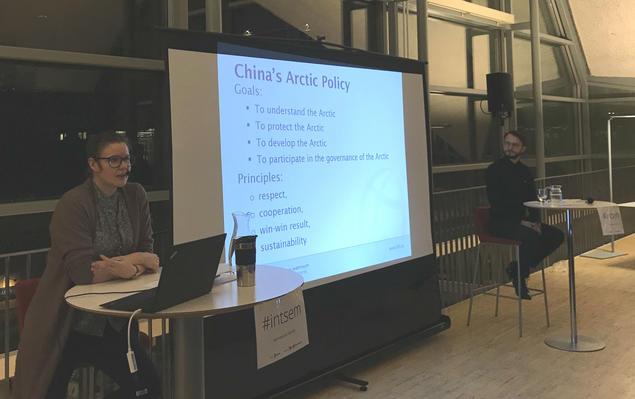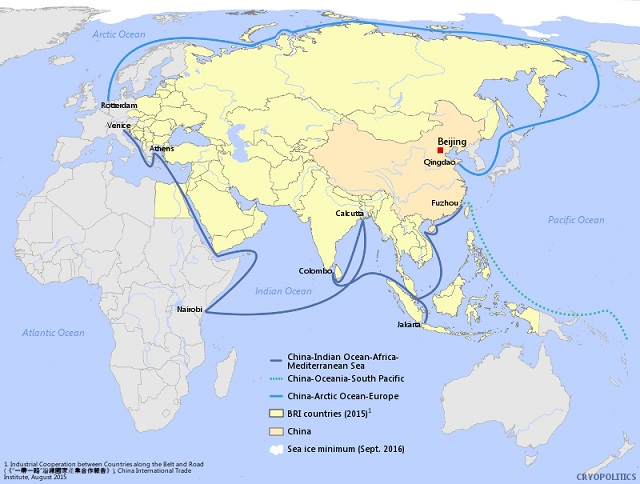A silk road on ice?

As the sea ice melts and the Arctic is opened to the exploration of resources and new transport routes, China is showing increased interest in the region.
At a recent seminar in Tromsø, FNI researcher and Director of the Global Programme, Iselin Stensdal, gave a talk on China’s ambitions and plans for the Arctic, with a focus on the ‘Polar Silk Road’ and resources. The seminar was organized by YATA Tromsø, Internasjonalt Seminar and the Tromsø Public Library. Piotr Graczyk, research fellow at the Department of Social Science at UIT and researcher at NORUT, moderated the event.
Active non-Arctic state
Despite being a non-Arctic state, China’s activity in the Arctic region is increasing. In 2013, China was granted observer status on the Arctic Council. Chinese companies also hold stakes in the Yamal liquefied natural gas project in Russia. In parallel with these developments, scepticism of China’s Arctic endeavours and uncertainty related to its long-term strategic interests have been mounting in recent years.
However, on 26 January 2018 the Chinese government published a white paper with its official Arctic policy, lessening uncertainties about what China wants in the Arctic.
Respect and environmental concerns
According to Stensdal, the Arctic white paper reveals a country seeking to show it is responsible, respectful and concerned about the environment.
‘The white paper’s tone is cautious and respectful, underscoring the  importance of observing international and domestic laws, mutual respect between countries, while acknowledging the Arctic states’ sovereignty. A great deal of space is devoted in the paper to understanding the environment and climate change, and protecting the vulnerable Arctic ecosystems’, Stensdal says.
importance of observing international and domestic laws, mutual respect between countries, while acknowledging the Arctic states’ sovereignty. A great deal of space is devoted in the paper to understanding the environment and climate change, and protecting the vulnerable Arctic ecosystems’, Stensdal says.
The white paper further specifies the areas and resources China is encouraging its enterprises to engage in. Oil, gas, and other minerals, fisheries and other living resources, as well as tourism are mentioned. The policy also states, ‘China hopes to work with all parties to build a “Polar Silk Road” through developing the Arctic shipping routes.’
Polar Silk Road
The idea of a polar silk road is not at all that new. It was first mentioned in June 2017, when China’s National Development and Reform Commission and State Oceanic Administration published the ‘Vision for Maritime Cooperation under the Belt and Road Initiative’. The initial structure of the Belt and Road Initiative (BRI) – a Chinese strategy focusing on connectivity and cooperation between countries – involved creating sea corridors through the Indian and Pacific Ocean to Africa, Europe, the Middle East and South Asia.
‘The inclusion of the Arctic demonstrates how the BRI has grown from a regional foreign-policy project to a more global undertaking. Other countries’ eagerness to join the BRI also demonstrates the influence China has in the world’, explains Stensdal.
But long road ahead
The allure of Arctic shipping routes – which connect China to Europe and the Americas – are reduced sailing distances and thereby saved fuel costs, and is  thought to impact Chinese trade and economic development positively.
thought to impact Chinese trade and economic development positively.
‘However, while the promises of an Arctic Silk Road are exciting for Chinese companies and potential Arctic partners, it is a long road ahead before traffic can increase and it can compete with other seaways’, says Stensdal.
‘Among the challenges are the lack of infrastructure, security concerns, and that existing shipping fleets are largely not suited for Arctic conditions. Furthermore, while there is less ice in the Arctic than previously, this does not mean there is no ice. Nevertheless, China has expressed its interest, mainly for economic reasons. Joining forces with Chinese partners may provide opportunities also for Arctic actors looking for ways to develop their Arctic communities,’ she concludes.
